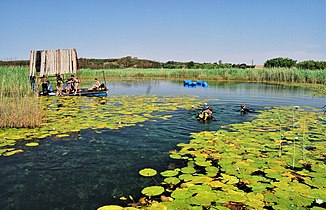Marico (river)
|
Marico Madikwe |
||
|
The Marico in the Limpopo catchment area (bottom left) |
||
| Data | ||
| location |
|
|
| River system | Limpopo | |
| Drain over | Limpopo → Indian Ocean | |
| source | south of Koster | |
| muzzle | Confluence with the Crocodile River and formation of the Limpopo Coordinates: 24 ° 11 ′ 28 ″ S , 26 ° 52 ′ 16 ″ E 24 ° 11 ′ 28 ″ S , 26 ° 52 ′ 16 ″ E |
|
| Mouth height |
872 m
|
|
| Catchment area | 13,208 km² | |
| Left tributaries | Little Marico, Sehubyane | |
| Reservoirs flowed through | Molatedi Dam, Marico-Bosveld Dam | |
| Small towns | Groot Marico , Ga-Mokatlha , Derdepoort , Sikwane | |
|
Eye of Marico |
||
The Marico River (also Maricorivier or Madikwe ) is a flow in the South African provinces Northwest (North West) and Limpopo , which is also along the border with Botswana and to a small extent within Botswana runs. It is the shorter of the two headwaters of the Limpopo .
History and usage
The source of the river is sometimes referred to as the Eye of Marico ("Eye of Marico"), a 17 meter deep spring basin to which aquifers lead. In the area of the source rivers, dolomitic rock complexes occur , which give the water a specific mineral content. Another such basin that feeds the river is the Molemane Eye ( Molemane Eye Nature Reserve ). The longest source river, however, has its source south of Koster in the western Witwatersrand . The upper reaches of the river is known as the Groot Marico . The city of the same name lies on him.
The Groot Marico flows northwards. It takes up the left-hand river Klein Marico and is then called Marico; also on the left is the tributary Sehubyane. The further north flowing Marico forms a section of the border between the provinces northwest and Limpopo. There is the Molatedi Dam and a little further downstream the Tswasa Weir . The Botswana capital Gaborone receives a large part of its drinking water through this weir as part of the Tswasa Water Scheme . The Marico then touches the Madikwe Game Reserve and meets the border between Botswana and South Africa at Derdepoort and Sikwane . From there it flows northeast as a border river between South Africa and Botswana. Shortly before the confluence with the Crocodile River , it runs a few kilometers within Botswana. After the confluence, the river is now called Limpopo, crossing the national territory of Mozambique and finally flowing into the Indian Ocean .
The Marico belongs to the Crocodile (West) Marico Water Management Area . Several reservoirs are located in the Marico catchment area :
- Molatedi Dam
- Kromellenboog Dam
- Marico-Bosveld Dam
- Uitkyk Dam
- Klein-Maricopoort Dam
- Sehujwane Dam
- Madikwe Dam
The average amount of water at the mouth of the Marico in the Limpopo is around 170 million cubic meters per year.
Others
The water quality is particularly good in the Groot Marico. Since 2010 there have been protests by the population against plans to mine various mineral resources such as nickel ores and diamonds in the Marico catchment area.
The endemic fish Marico barb ( Enteromius motebensis ), which belongs to the Cyprinidae , is named after the river.
Web links
- Waters in the area of the Crocodile River / Marico River, survey from 2004 at dwaf.gov.za (PDF; English; archive version)
Individual evidence
- ^ Frederick H. Hatch: The Geology of the Marico District, Transvaal . In: Transactions of the Geological Society of South Africa. Vol. 7 (1904), issue 1 pp. 1-6 (3 illustration supplements)
- ^ Republic of South Africa, Department of Environmental Affairs and Tourism: Crocodile (West) Marico. Water Management Area . State-of-Rivers Report: Monitoring and Managing the Ecological State of Rivers in the Crocodile (West) Marico Water Management Area. Pretoria 2005 ISBN 0-620-34054-1 , originally from www.dwaf.gov.za (PDF; English; archive version )
- ^ Community of Groot Marico: Marico petition. In: www.marico.co.za from August 2010 (English), accessed on April 1, 2020
- ↑ International Union for Conservation of Nature and Natural Resources : IUCN Red List. In: www.iucnredlist.org (English), accessed April 1, 2020


